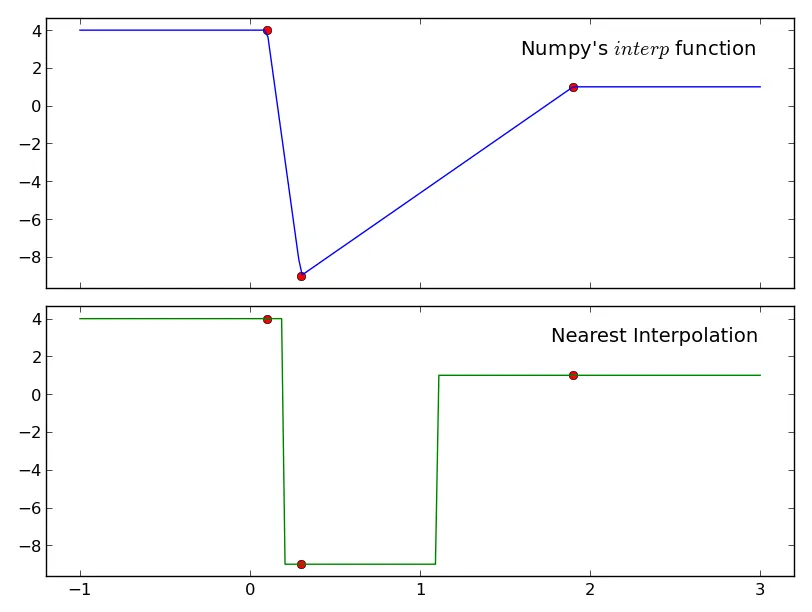我想找到以下Matlab语句在Python中的等效语句:
vq interp1(x,y, xq,'nearest','extrap')
看起来interp(xq, x, y)对于线性插值/外推工作得非常好。
我也查看了
F = scipy.interpolate.interp1d(x, y, kind='nearest')
这个方法对于最近的距离算法是完美的,但不会进行外推。
我有没有忽略其他什么?谢谢。
我想找到以下Matlab语句在Python中的等效语句:
vq interp1(x,y, xq,'nearest','extrap')
看起来interp(xq, x, y)对于线性插值/外推工作得非常好。
我也查看了
F = scipy.interpolate.interp1d(x, y, kind='nearest')
这个方法对于最近的距离算法是完美的,但不会进行外推。
我有没有忽略其他什么?谢谢。
要进行使用最近插值法的线性插值,请使用numpy.interp。这是默认设置。
例如:
yi = np.interp(xi, x, y)
def nearest_interp(xi, x, y):
idx = np.abs(x - xi[:,None])
return y[idx.argmin(axis=1)]
或者更高效的方法是使用searchsorted:
def fast_nearest_interp(xi, x, y):
"""Assumes that x is monotonically increasing!!."""
# Shift x points to centers
spacing = np.diff(x) / 2
x = x + np.hstack([spacing, spacing[-1]])
# Append the last point in y twice for ease of use
y = np.hstack([y, y[-1]])
return y[np.searchsorted(x, xi)]
import numpy as np
import matplotlib.pyplot as plt
def main():
x = np.array([0.1, 0.3, 1.9])
y = np.array([4, -9, 1])
xi = np.linspace(-1, 3, 200)
fig, axes = plt.subplots(nrows=2, sharex=True, sharey=True)
for ax in axes:
ax.margins(0.05)
ax.plot(x, y, 'ro')
axes[0].plot(xi, np.interp(xi, x, y), color='blue')
axes[1].plot(xi, nearest_interp(xi, x, y), color='green')
kwargs = dict(x=0.95, y=0.9, ha='right', va='top')
axes[0].set_title("Numpy's $interp$ function", **kwargs)
axes[1].set_title('Nearest Interpolation', **kwargs)
plt.show()
def nearest_interp(xi, x, y):
idx = np.abs(x - xi[:,None])
return y[idx.argmin(axis=1)]
main()

scipy.interpolate.interp1d有选项fill_value = “extrapolate”。import pandas as pd
>>> s = pd.Series([1, 2, 3])
Out[1]:
0 1
1 2
2 3
dtype: int64
>>> t = pd.concat([s, pd.Series(index=s.index + 0.1)]).sort_index()
Out[2]:
0.0 1.0
0.1 NaN
1.0 2.0
1.1 NaN
2.0 3.0
2.1 NaN
dtype: float64
>>> t.interpolate(method='nearest')
Out[3]:
0.0 1.0
0.1 1.0
1.0 2.0
1.1 2.0
2.0 3.0
2.1 NaN
dtype: float64
>>> t.interpolate(method='nearest', fill_value='extrapolate')
Out[4]:
0.0 1.0
0.1 1.0
1.0 2.0
1.1 2.0
2.0 3.0
2.1 3.0
dtype: float64